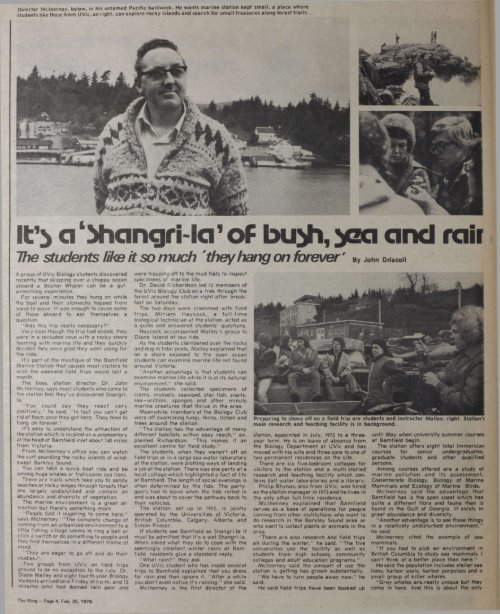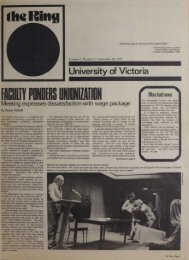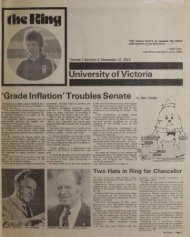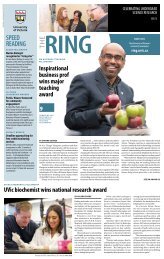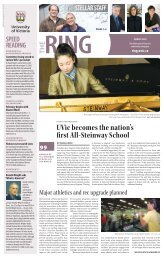extensive
Volume 2, Number 4, February 25, 1976 - The Ring - University of ...
Volume 2, Number 4, February 25, 1976 - The Ring - University of ...
- No tags were found...
Create successful ePaper yourself
Turn your PDF publications into a flip-book with our unique Google optimized e-Paper software.
Director Mclnerney, below, in his untamed Pacific bailiwick. He wants marine station kept small, a place where<br />
students like those from UVic, on right, can explore rocky islands and search for small treasures along forest trails.<br />
The students like it so much 'they hang on forever' By John Driscoll<br />
A group of UVic Biology students discovered<br />
recently that skipping over a choppy ocean<br />
aboard a Boston Whaler can be a gutwrenching<br />
experience.<br />
For several minutes they hung on while<br />
the boat and their stomachs hopped from<br />
wave to wave. It was enough to cause some<br />
of those aboard to ask themselves a<br />
question.<br />
"Was this trip really necessary?"<br />
Very soon though the trip had ended, they<br />
were in a secluded cove with a rocky shore<br />
teeming with marine life and they quickly<br />
decided they were glad they went along for<br />
the ride.<br />
It's part of the mystique of the Bamfield<br />
Marine Station that causes most visitors to<br />
wish the weekend field trips would last a<br />
month.<br />
The boss, station director Dr. John<br />
Mclnerney, says most students who come to<br />
the station feel they've discovered Shangrila.<br />
"You could say they react very<br />
positively," he said. "In fact you can't get<br />
rid of them once they get here. They tend to<br />
hang on forever."<br />
It's easy to understand the attraction of<br />
the station which is located on a promontory<br />
at the head of Bamfield inlet about 140 miles<br />
from Victoria.<br />
From Mclnerney's office you can watch<br />
the surf pounding the rocky islands of windswept<br />
Barkley Sound.<br />
You can take a quick boat ride and be<br />
among huge whales or frolicsome sea lions.<br />
There are trails which take you to sandy<br />
beaches or rocky ledges through forests that<br />
are largely undisturbed and contain an<br />
abundance and diversity of vegetation.<br />
The marine environment is a great attraction<br />
but there's something more.<br />
"People find it inspiring to come here,"<br />
says Mclnerney. "The complete change of<br />
coming from an urbanized environment to a<br />
little fishing village seems to ring a bell or<br />
click a switch or do something to people and<br />
they find themselves in a different frame of<br />
mind.<br />
"They are eager to go off and do their<br />
studies."<br />
Two groups from UVic on field trips<br />
proved to be no exception to the rule. Dr.<br />
Diane Malley and eight fourth-year Biology<br />
students arrived on a Friday at 5 p.m. and 15<br />
minutes later had donned rain gear and<br />
were trouping off to the mud flats to inspect<br />
specimens of marine life.<br />
Dr. David Richardson led 12 members of<br />
the UVic Biology Club on a trek through the<br />
forest around the station right after breakfast<br />
on Saturday.<br />
The two days were crammed with field<br />
trips. Miriam Haycock, a full-time<br />
biological technician at the station, acted as<br />
a guide and answered students' questions.<br />
Haycock accompanied Malley's group to<br />
Diana Island at low tide.<br />
As the students clambered over the rocks<br />
and dug in tidal pools, Malley explained that<br />
on a shore exposed to the open ocean<br />
students can examine marine life not found<br />
around Victoria.<br />
"Another advantage is that students can<br />
examine marine life while it is in its natural<br />
environment," she said.<br />
The students collected specimens of<br />
clams, mussels, seaweed, star fish, snails,<br />
sea-urchins, sponges and other minute<br />
marine creatures that thrive in the area.<br />
Meanwhile, members of the Biology Club<br />
were off examining fungi, ferns, lichen and<br />
trees around the station.<br />
"The station has the advantage of many<br />
different habitats within easy reach," explained<br />
Richardson. "This makes it an<br />
excellent centre for field study."<br />
The students, when they weren't off on<br />
field trips or in a large sea-water laboratory<br />
at the station, were plotting ways of landing<br />
a job at the station. There was one party at a<br />
local cottage which highlighted a fact of life<br />
at Bamfield. The length of social evenings is<br />
often determined by the tide. The partygoers<br />
had to leave when the tide rolled in<br />
and was about to cover the pathway back to<br />
their vehicles.<br />
The station, set up in 1972, is jointly<br />
operated by the Universities of Victoria,<br />
British Columbia, Calgary, Alberta and<br />
Simon Fraser.<br />
If students see Bamfield as Shangri-la it<br />
must be admitted that it's a wet Shangri-la.<br />
When asked what they do to cope with the<br />
seemingly constant winter rains at Bamfield,<br />
residents give a standard reply.<br />
"What rain?" they ask.<br />
One UVic student who has made several<br />
trips to Bamfield explained that you dress<br />
for rain and then ignore it. "After a while<br />
you don't even notice it's raining." she said.<br />
Mclnerney is the first director of the<br />
Preparing to shove off on a field trip are students and instructor Malley, right. Station's<br />
main research and teaching facility is in background.<br />
station, appointed in July, 1975 to a threeyear<br />
term. He is on leave of absence from<br />
the Biology Department at UVic and has<br />
moved with his wife and three sons to one of<br />
two permanent residences on the site.<br />
There are six five-bedroom cottages for<br />
visitors to the station and a multi-storied<br />
research and teaching facility which contains<br />
Salt water laboratories and a library.<br />
Philip Rhynas, also from UVic, was hired<br />
as the station manager in 1973 and he lives in<br />
the only other full-time residence.<br />
Mclnerney explained that Bamfield<br />
serves as a base of operations for people<br />
coming from other institutions who want to<br />
do research in the Barkley Sound area or<br />
who want to collect plants or animals in the<br />
area.<br />
"There are also research and field trips<br />
all during the winter," he said. "The five<br />
universities use the facility as well as<br />
students from high schools, community<br />
colleges and adult education programs."<br />
Mclnerney said the amount of use the<br />
station is getting has grown substantially.<br />
"We have to turn people away now," he<br />
said.<br />
He said field trips have been booked up<br />
until May when university summer courses<br />
at Bamfield begin.<br />
The station offers eight total immersion<br />
courses for senior undergraduates,<br />
graduate students and other qualified<br />
persons.<br />
Among courses offered are a study of<br />
marine pollution and its assessment,<br />
Coelenterate Biology, Biology of Marine<br />
Mammals and Ecology of Marine Birds.<br />
Mclnerney said the advantage that<br />
Bamfield has is the open coast which has<br />
quite a different flora and fauna than is<br />
found in the Gulf of Georgia. It exists in<br />
great abundance and diversity.<br />
"Another advantage is to see these things<br />
in a relatively undisturbed environment,"<br />
he said.<br />
Mclnerney cited the example of sea<br />
mammals.<br />
"If you had to pick an environment in<br />
British Columbia to study sea mammals I<br />
can't think of a better place than here."<br />
He said the population includes stellar sea<br />
lions, harbor seals, harbor porpoises and a<br />
small group of killer whales.<br />
"Grey whales are really unique but they<br />
come in here. And this is about the only<br />
The Ring - Page 4, Feb. 25, 1976


